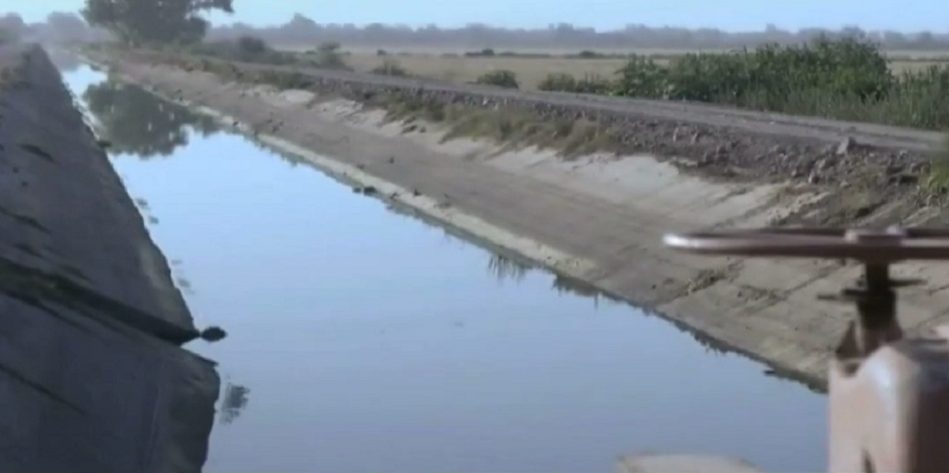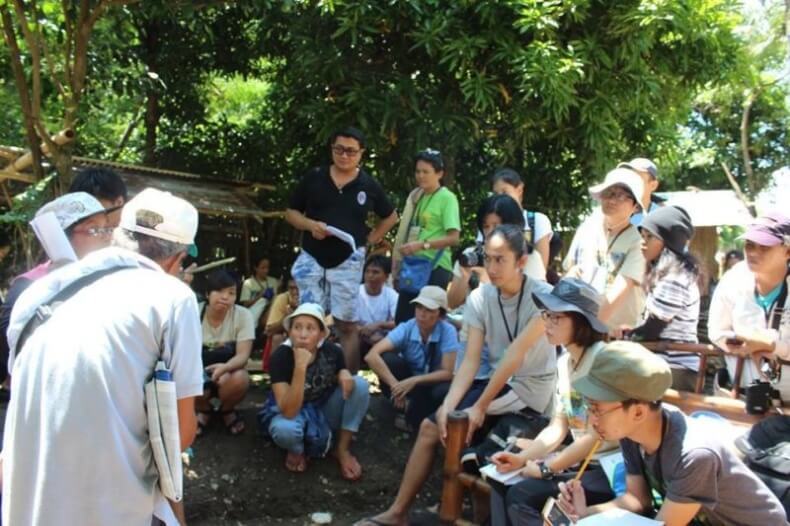
by Deep Green Resistance News Service | Aug 19, 2016 | Biodiversity & Habitat Destruction, Colonialism & Conquest
Featured image: International Solidarity Mission delegates listen to testimonies by Tumandok men and women in Barangay Agcalaga, Calinog. Photo Credits: Jalaur River for the People Movement.
By Karlo Mikhail Mongaya, GlobalVoices
The Tumandok (Panay-Bukidnon) indigenous peoples of the central Philippine Island of Panay are facing the real possibility of being forced from their homes due to the construction of the Jalaur Mega Dam, which will leave indigenous communities in the municipality of Calinog, Iloilo underwater.
Also known as the Jalaur River Multipurpose Project Phase 2 (JRMP II), the project is expected to displace 17,000 Tumandok individuals, affecting 16 indigenous people’s communities. The building of the dam will submerge houses and agricultural lands of the Tumandok.
These were the findings of the International Solidarity Mission (ISM) from July 16 to 18 organized by the Jalaur River for the People Movement. Delegates representing 26 organizations from five countries, including Belgium, Germany, Italy, Philippines, and South Korea, took part in the ISM.
The ISM delegates trekked to the indigenous communities along the Jalaur River in Calinog that are directly affected by the dam construction, talked with local officials, and dialogued with concerned government agencies in Iloilo City.

The Binanog dance performed during the 2016 Tumanduk nga Mangunguma nga Nagapangapin sa Duta kag Kabuhi (TUMANDUK) Assembly held in Tapaz, Capiz earlier this year. Photo Credits: TUMANDUK.
The Jalaur Mega Dam had its groundbreaking ceremony with former President Noynoy Aquino on February 2013 and is mainly funded by a loan from the Export Import Bank of Korea, with subsidies from the Philippine government.
The Philippine government is pushing for the construction of the Jalaur Mega Dam as the solution to providing irrigation and potable water in Panay Island. However, critics assert the same can be achieved without destroying indigenous communities by building smaller dams and rehabilitating existing irrigation systems.
Dr. Ernesto Hofileña, a retired anesthetist and agriculturist from Iloilo, for instance, argues that maximizing the 1,500-square kilometer catchment area that collects rain and run-off water downstream is better than constructing a big dam upstream where the catchment area is only 107 square kilometers. He wrote:
The average annual output of the Jalaur River is 1,197,504,000 cubic meters. If we can save this using a series of small dams, reservoirs, and deep lateral canals crisscrossing the farmlands across the Iloilo plain we won’t need a high dam with a storage capacity of less than a billion.
Manufacturing consent
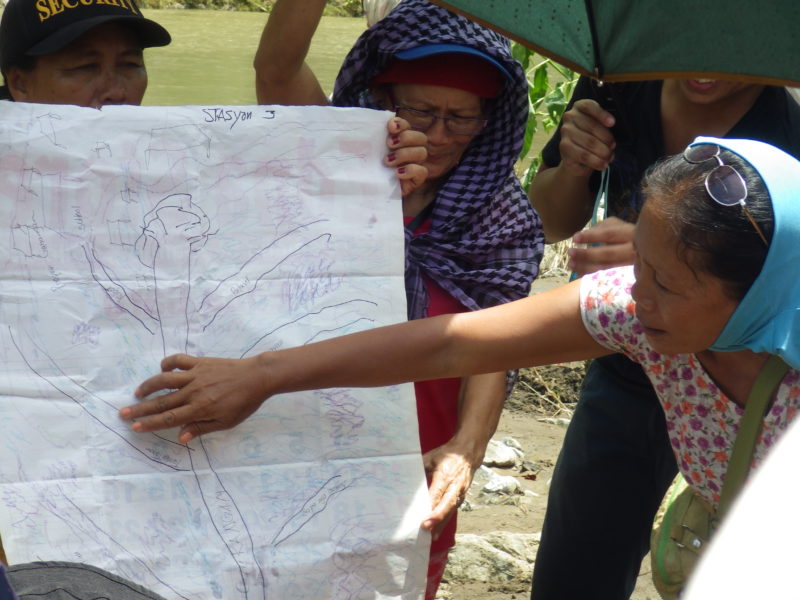
The Tumandok mapping the destruction and displacement to be caused by the construction of the Jalaur Mega Dam. Photo Credits: Jalaur River for the People Movement.
Contrary to the claims of the national and local government of almost full support by the indigenous peoples for the project, the international mission found out that no real free, prior, and informed consent (FPIC) was obtained from the Tumandok for the construction of the Jalaur Mega Dam.
In the first place, the ISM reported that the feasibility study made by the National Irrigation Administration for the dam construction was already tendered to the Korea Eximbank in November 2011. This was before the initiation of the first FPIC process on January 2012.
The ISM also found that the “consultative assemblies” organized by the National Commission on Indigenous Peoples only presented the advantages of building the Jalaur Mega Dam while masking the negative effects.
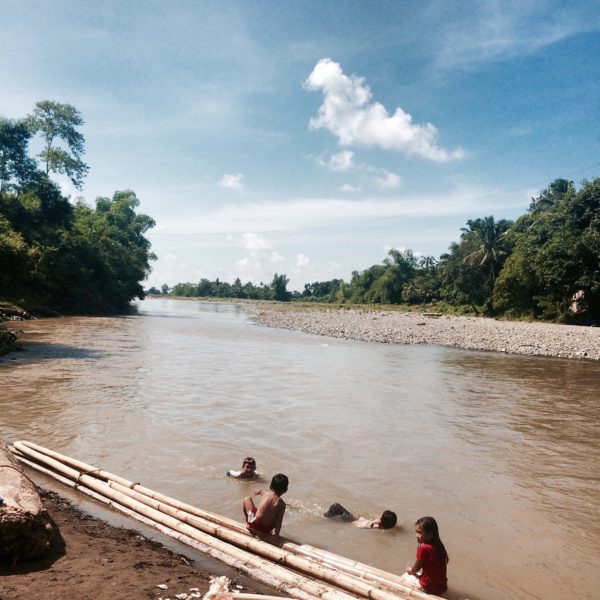
Children playing along the river banks of Jalaur in Barangay Agcalaga, Calinog.
Affected communities were given promises of incentives so that they would support the project, while those who resisted were threatened and intimidated by state forces.
Berna Castor, leader of the indigenous people’s group Tumanduk nga Mangunguma nga Nagapangapin sa Duta kag Kabuhi (TUMANDUK), said the elders who consented to the dam were not voted by the entire community and were organized by authorities precisely for the purpose of giving legitimacy to the project. Castor said:
Yes, they are Tumandok. But they are those whose lives and livelihood are not directly affected by the project. The people who will be most affected by the project do not approve of the project.
The Tumandok men and women who spoke to the ISM delegation shared their fears of flooding and landslides that the dam could cause as well as the drowning not only of their homes and villages, but also of their agricultural lands and cultural heritage.
Six Tumandok burial grounds and sacred sites along the Jalaur River will be desecrated with the building of the dam, according to a research study presented during the ISM by University of the Philippines Visayas graduates Mar Anthony Balani and Jude Mangilog.
Call to action and recommendations

Delegates of the International Solidarity Mission fording the Jalaur River.
The international mission’s call to actions included an appeal for the Philippine government to respect the right of the Tumandok to their ancestral domain and their processes of decision-making without coercion, bribery and false promises from government agencies and the military.
The mission demanded the stop of the militarization of indigenous communities and the investigation of human rights abuses that were committed to coerce the Tumandok into consenting to the project. It also called for the indemnification of the victims for damages during the project’s implementation.
The international mission moreover urged for the review of all development projects that encroach on the Tumandok people’s ancestral domain and likewise called on the South Korean government, the loan provider, to re-evaluate the issues surrounding the dam.
Finally, the mission recommended the conduct of an independent study assessing the viability of the proposed Jalaur Mega Dam as well as the feasibility of alternatives such as the building of small and micro-dams that are less dangerous while still providing irrigation water for farmlands.
This article was originally published at GlobalVoices, republished under Creative Commons (CC BY 3.0) License
by Deep Green Resistance News Service | Jul 10, 2016 | Biodiversity & Habitat Destruction, Colonialism & Conquest
By Carlos Enrique Maibeth-Mortimer / Intercontinental Cry
There is a crisis erupting in Nicaragua’s North Caribbean Autonomous Region that spans across all social and economic boundaries, affecting everything from human rights to ecosystem preservation to climate change. The Indigenous Miskitu and Mayagna Peoples, whose traditional cultural practices are inseparably linked to the environment and who exist at the forefront of imminent climate shifts capable of displacing entire communities, are under attack. The situation is one that world doesn’t yet know about. It is incumbent upon all of us to change that–to do what we can to empower the Native Peoples of Nicaragua, and stop the destruction.
Settlers are attacking Indigenous communities with automatic firearms, killing, plundering and forcing residents to flee their ancestral lands. Foreign companies have entered the territory illegally and are burning the region’s precious stronghold of biodiversity and natural resources at an alarmingly rapid rate.
Disturbing reports continually come to light of dozens of killings and kidnappings, particularly of Miskitu Indigenous men and women. Thousands of Indigenous refugees have been forced to flee their communities to the relative safety of more urban areas. With no support services intact to deal with the influx of refugees in the already strained resources of the urban regions, those fleeing the violence continue to suffer a lack of food and lack of medical attention upon arrival. The murderous ‘colonos’ operate with complete impunity. As a result, the attacks continue unrestrained by Nicaraguan law enforcement, contributing to a climate of escalation. There is a real and valid concern regarding the virtual media blackout, in both local and international spheres, where little to no reporting focuses on the critical situation unfolding.
Inhabitants of the Atlantic Coast, or Costeños as they are collectively known to the rest of Nicaragua, represent a unique diversity of ethnic groups including Indigenous Miskitu, Mayagna, and Rama, Garífuna (descended from African slaves and Carib Indians), English-speaking Creoles (descendants of African slaves), and Mestizos (mixed race Latin Americans descended from European colonizers and Native peoples).
The region was deeply impacted – scarred even – by the revolutionary war of the 1980’s, when US-backed counter-revolutionaries mounted attacks against the Sandinistas from military bases in Honduras, just across the Coco (Wangki) River.
In 1987, with the war raging, the Autonomy Statute for the Atlantic Coast was enacted and amended to the Nicaraguan Constitution. The new law recognized the multi-ethnic nature of the communities of the Atlantic coast; and in particular, noted Indigenous peoples’ rights to identity, culture and language. The new Autonomous Regions were divided between the North and the South.
In 2003 the Nicaraguan National Assembly finally passed the Communal Property Regime Law 445 and the Demarcation Law to address Indigenous concerns regarding land demarcation and natural resources after much pressure from international institutions.
Indigenous people have legal ownership to significant portions of their ancestral lands as assured by Nicaraguan law, in addition to the Indigenous and Tribal Peoples Convention 169 ratified by Nicaragua in 2010 and the United Nations Declaration on the Rights of Indigenous People. Yet realities have differed from legalities. Although the Autonomy Agreement recognized collective land holdings, Indigenous people did not actually hold the legal title to their lands for a long time. In recent years, while Indigenous people have been waiting for formal title to be issued to their lands, false titles have been issued in Managua or elsewhere, selling land illegally to settlers from outside the region. It is a sad reality that although Law 445 calls for the removal of illegal settlers from Indigenous lands, it is increasingly undeniable that the exact opposite has taken place.
Violent conflicts over Indigenous land rights have been increasingly erupting in the remote areas of the Northern Caribbean Autonomous Region. Since September 2015, the Miskitu settlements of Wangki, Twi-Tasba Raya, and Li Aubra, have come under especially heavy attack. Reports indicate as many as 80 Miskitu men have been killed or kidnapped from these regions alone; while as many as 2,000 refugees fled their homes and communities in fear for their very lives. These particular villages have been hit especially hard by the violent conflict and, despite pleas for help at municipal and national levels, have received no measure of protection or even investigation, much less prosecution.
Transnational lumber companies siphoning profits from the region’s natural resources have been operating out of nearby Honduras. They are carrying out sophisticated lumbering operations utilizing helicopters and cargo boats to facilitate the rapid export of extracted wood. Nicaragua is home to the Bosawas Biosphere Reserve, one of the largest tropical rainforests in the Americas, second only to the Amazon. The world can no longer stand by while this stronghold of biodiversity and climate-stabilizing carbon-mitigating forest is sacrificed to next quarter’s profits.
Pleas for help have seemed to fall on deaf ears in the capital city of Managua. The Nicaraguan government has not officially acknowledged any of the most recent and most egregious killings, illegal land occupation or deforestation issues. The socialist central government has not offered any plan for addressing this escalating humanitarian crisis, for providing any gestures of protection to the Indigenous communities under attack nor assistance to the refugees. Many Indigenous to the region cannot help but suspect that human rights violations and land rights violations may be happening with the silent consent of the central Nicaraguan government.
While much attention has been given to the Nicaraguan government’s sale of a concession to a Chinese investment firm for an ill-conceived canal to run through the Southern Caribbean Autonomous Region, virtually no media attention has focused on the current urgent crisis in the Northern Region.
Thousands of illegal settlers have clear cut precious rainforest – indifferent to immediate or long term impacts – and have begun to establish cattle ranches and lumber operations that are completely inappropriate to the ecology of the region. The environmental impact mirrors the destructive patterns playing out in the Amazon Basin.
The Bosawas Biosphere Reserve is located in the North Caribbean Autonomous Region in an area historically occupied by Indigenous Mayagna and Miskitu people. The reserve has been designated a UNESCO World Heritage site due to its unique ecological and biocultural significance. The negative impacts on this vulnerable area in particular have consequences not only for Nicaragua, but also for the whole planet. Tropical rainforests hold 50 percent more carbon than trees elsewhere. To this end, deforestation of tropical forests actually causes much more carbon to be released. The problems associated with illegal human migration to the region and its effect on the natural ecology and rates of deforestation are grave, with worldwide ecological consequences.
Although there are differences among settler groups, what they have in common is an environmentally destructive cultural mentality. It is not a coincidence that the settler groups who have inflicted the worst environmental destruction have simultaneously inflicted the worst violence against Indigenous Miskitu and Mayagna.
The critical cultural differences between the Native populations and the non-Indigenous settlers can result in vastly different outcomes for the natural environment. These key cultural differences include: property regimes, expansion patterns, agricultural practices and long-term economic strategies. Indigenous communities hold land in common, meaning that they have collective ownership of their territories. Mestizo settlers, on the other hand, exercise a private property model and parcel out land that they have settled and/or seized.
Significant differences in the use and care of livestock can have a major environmental impacts. On average, only 10 percent of Indigenous families have cattle, whereas mestizo settlers average one cow per family. The low cattle count among Indigenous families, along with their nucleated communities, means that cattle are kept within the limits of the village, along with other livestock like pigs. The Indigenous people of the region contain their animals within the perimeter of their communities, whereas crops are planted in wooded areas up to a two-hour radius from community centers.
When mestizo settlers move into the region they re-shape and redistribute the land with the driving purpose of raising cattle and in anticipation of obtaining even more cattle in the future. After clear-cutting invaluable rainforest land, they immediately begin sowing grass seed and other crops. Within one season, their crop fields are converted into more pasture land. Indigenous farmers, on the other hand, will cut back specific plots of rainforest but will only use these plots for a year or two. They then allow them to grow back and move on to another area to develop communal plots. This traditional Indigenous practice of land management allows the rain forest to regenerate and recover — a sustainable method the Indigenous biostewards of the region have practiced for thousands of years.
On the other hand, mestizo settlers often cause irreversible damage to the rainforest. Settler occupations seem bent on developing as much pasture as possible. If they have the economic means, they raise more cattle and continually increase the herd size. If they do not have the means for raising cattle, they sell this land to settlers who do have cattle. This is the way in which mestizo settlers illegally appropriate traditional Indigenous territory and cash in on the destructive practices they inflict on it soon after. This type of land speculation and ‘economic development’ is almost nonexistent among Indigenous groups, and many view it as a direct challenge to their inherent values. Ironically, many mestizos use this conservative approach to concoct a false narrative that Indigenous people are lazy and undeserving of their vast quantities of land.
Even with growing populations, indigenous communities have a relatively low environmental impact compared to their mestizo non-Indigenous counterparts. The differences in environmental impact and lifestyles between Indigenous and mestizo communities put land tenure and environmental conservation in perspective.
Significant progress towards honoring Indigenous land rights must be a crucial component in the creation of a multi-stakeholder enforced strategy to protect the environmental integrity of the Autonomous Region of Northern Caribbean. It becomes especially critical when considering the overarching role tropical rainforests play in regulating the Earth’s climate.
The two factors of tropical deforestation and human-induced global warming are inextricably connected. There is a definite consensus in the scientific community that deforestation is one of the innate causes behind global warming. According to the Food and Agricultural Organization of the United Nations, “… Between 25 to 30 percent of the greenhouse gases released into the atmosphere each year —1.6 billion tons — are caused by deforestation.” Contributing to deforestation is by definition contributing to global warming.
It’s important to really drive home the compounding effects of the destruction of tropical rainforest: is it is even more damaging to the environment than destruction of other types of forest because of the unique ecology of rainforests. Compared to boreal forests, which are much more expansive, each square hectare of tropical rainforest holds nearly 50 percent more carbon.
The carbon within tropical rainforests is split pretty evenly between soils and flora. When tropical rainforests are clear-cut,massive amounts of carbon are released. Warmer temperatures cause soil to more rapidly decompose.
Tropical forests sequester more carbon because they grow year round and faster than other forest types. When protected and preserved, tropical rainforests are able to actually take in more carbon than they release into the atmosphere, critically reducing the adverse effects of fossil fuel emissions. To put things in clear perspective, tropical rainforests produce 20 percent of the world’s oxygen and 30 percent of the world’s freshwater.
When tropical forestland is transformed into pasture and overused, it leads to a steady cycle of desertification. Rainforests hold together the soil and ensure that it is saturated with rich nutrients. Over time, cattle grazing on pasture land created by clear-cutting forest will quantifiably weaken the soil. Monsoon seasons that are prevalent in Eastern Nicaragua steadily wash away any topsoil that no longer has forests holding it together or nourishing it. Without trees this lower-level soil cannot adequately absorb water. This further leaves areas more susceptible to flooding and landslides. Manure, fertilizer and pesticide runoff are contaminating and acidifying nearby waterways, killing off flora and fauna that are critical to the integrity of intact forests. During the summer months, this lower-level soil bakes and cracks, slowly developing into desert.
Lest it seem the many and crucial challenges facing the Indigenous people of Nicaragua are insurmountable in the face of such great adversity, Native Miskitu and Mayagna continue to defy the odds and act as trailblazers. Their actions set a prime example of what can be accomplished, even with minimal resources.
Although many of the Native people of Nicaragua are not familiar with the Pan-Indigenous American movement known as Idle No More, their actions are living embodiments of the mantra. They have consistently and repeatedly sought assistance and protection from local and national authorities, yet their pleas for help have fallen on deaf ears. No meaningful action has been taken by any government authority. The problem of Indigenous land rights violations and removal of the settlers has been presented to the OAS (Organization of American States) and the IACHR (Inter-American Court of Human Rights). The issue has even been formally raised at the United Nations Permanent Forums on Indigenous peoples.
NGOs played a supportive role in pressuring the Nicaraguan government to institute necessary jurisprudence in protecting environment and Indigenous land rights; the problem is that the laws are not being respected or enforced. The government continues to ignore the laws both at the national and local level. Mounting anecdotal evidence points to the possibility of corrupt officials contributing to the problem, at virtually every level of government. Through their inexcusable silence and inaction in the face of the escalating crisis, government at all levels is complicit at least in actively undermining Indigenous Peoples’ rights to their legal territories.
This is an ongoing crisis in the Autonomous Region of Northern Caribbean Nicaragua. The Indigenous cultures of the region are inseparably linked to the natural environment. The legal protections for Native people and the rain forest are being flagrantly violated by increasingly violent mestizo colonists (‘colonos’). Government at all levels has proven ineffectual in the face of the crisis. There has been no media coverage of this crisis, the escalation of violence, or the plight of refugees fleeing the areas of conflict.
It’s also important for us to help stop the destruction of the tropical rainforest, which is critically important to all of us. Government inaction in the face of mounting numbers of refugees and killings is morally corrupt and warrants international outcry.
The Indigenous Miskitu and Mayagna are not passive victims, but they are facing a tremendous challenge to address a problem of this magnitude. They are in desperate need of assistance to overcome this crisis.
5 WAYS YOU CAN HELP
- It is very important for international media outlets to focus on what is happening in this remote region. Spreading the word through social media will be key to applying international pressure to help the refugees and stop the killing of both the Indigenous people and the rainforest.
- There is an equal need for conventional media coverage. To that end, you can reach out to your favorite news outlet and encourage them to take on the story
- Costa Rica, Mexico, and the U.S. government have issued travel bans to Nicaragua, nevertheless, there is a growing need for humanitarian aid and witnesses to document what’s happening on the ground.
- If you want to support the Miskitu and Mayagna from home, consider organizing a community event or any kind of online action to make sure the world knows what’s happening.
- You can also ask the Ortega government to do the right thing, by working with the Miskitu and Mayagna to secure their ancestral territory, addressing the ongoing land theft and responding to the brutal attacks that are being carried out at the hands of the Colonos.
by Deep Green Resistance News Service | Jul 8, 2016 | Colonialism & Conquest, Male Violence, Rape Culture
By Terese Mailhot / Indian Country Today Media Network
My auntie says there’s a direct connection between violence against the earth and violence against Indigenous women. I think of my own brown body when she says this, and how it was damaged in childhood and adolescence. My memories feel stolen like the land, stripped like the languages, and entrapped like the bones of our ancestors in government storage.
I’ve spent the last year remembering abuse my father inflicted, and it’s been tough for my brothers, my sister, my babies, and my husband. I spent the morning asking my brother what he can remember, and piecing those fragments to my own. Still, there’s no clear image of the exact chaos my father created. One brother can remember the house turned upside down when he left, another can only remember it might be best to forget, and my loving sister can only say Dad was sadistic. I am unwilling to empathize with him, even though he was emasculated by the government as an Indian man, abused as a child, and institutionalized.
I used to think it was ethnocentric to say Natives didn’t experience abuse before colonialism. I’m on the fence about the topic, still, but I’m willing to make the conceit that sexuality wasn’t contextualized the way it is now as when my nation was thriving. Western construct, the bourgeoisie, and European culture invented the concepts of pedophilia and sexual abuse, so who’s to say that they didn’t also invent the acts. Whether Indigenous children or women experienced sexual violence before colonization is debatable, but I think the debate is sullied by Western thought and colonization, like so many things.
I feel like there’s a direct connection between the memories that feel stolen from me and the land Indigenous people grieve for. Within colonial log transcript, one will find that sexual violence pervaded Indigenous communities as a means to sublimate and de-humanize the people. How could the violence inflicted upon me be removed from this? It feels inherited. I’m not a soft-hearted woman who would say my father hurt women because someone hurt him, but I can say without question that I have been hurt by men because of the historical violence against Indigenous women. Just like the categorization of sexuality sprouted from Western thought, so did sexual violence as a means to colonize. Violence against Indigenous women is too common. The sexualization of Indigenous women is familiar to all North Americans. The “squaw,” and “savage,” imagery remains constant within our society. Colonization was successful in its ability to invite the degradation of our women. It’s practically promoted. One only has to observe the way Indigenous women go missing in Canada to see how prevalent the issue is.
I had panic attacks when I first started remembering. My bones felt immovable, and my eyes felt obscene in the light of day, and my body felt dirty. There’s a connection looming in my mind between the countless artifacts our government and museums have excavated from Indigenous lands and how much my memories feel locked away. The truth of my life, my memory, can’t be found within white institutions like hospitals. It can only be found beneath the iconography and stories of my culture. There’s a story that women where I’m from were given two items when they could speak: a club and a fishing weir. One item to protect, and another to provide. When the girl speaks with her items for the first time, she declares that she has a club and a weir, and asks the world which they want from her. Women where I’m from must protect themselves and provide for the community. After Indian boarding school, our communities stopped practicing the ceremony. Women were left clubless when the club was crucial. Through decolonization, the story has been excavated and a metaphorical club has been given to me.
I stand with my club, and carry the ability to nourish my children, my family, and my community. The connection for me is as irrefutable as my body, which can be broken, subject to discrimination, ignorance and judgment. The connection between my body and my land is one of the few things colonialism couldn’t take from me. As I journey towards reconciliation with my body, I feel like I am no longer invisible, and that I am taking up space within a continuum of historical erasure.
Terese Marie Mailhot is from Seabird Island Indian Band. Her work has been featured in The James Franco Review, The Offing, and Yellow Medicine Review. She’s a student at the Institute of American Indian Arts and she is a Discovery Fellowship recipient.
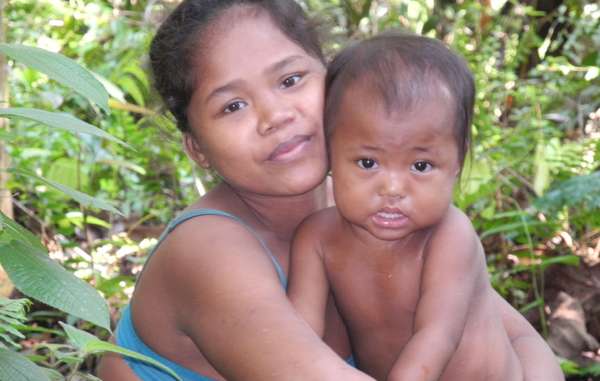
by Deep Green Resistance News Service | Jun 27, 2016 | Colonialism & Conquest
Featured Image: The Orang Rimba have lived in the forests of Sumatra for generations, but now they are under threat. © Survival International
By Survival International
Members of the nomadic Orang Rimba tribe in Indonesia have been attacked and their possessions burned as part of an eviction from a palm oil plantation on their ancestral land.
The Orang Rimba are a nomadic hunter-gatherer tribe who have been dependent on and managed their forest home in Sumatra for generations. Although a national park was created to protect local wildlife and – unprecedented in Indonesia – the tribe, the Indonesian government has signed over most of their ancestral lands to palm oil, timber and other plantation companies.
As a result many Orang Rimba are forced to live in plantations, collecting palm oil seeds and hunting wild boar. For collecting the seeds, the tribe have been accused of theft by the company operating in the area, even though the oil palm is on Orang Rimba ancestral land and the tribe do not regard such foraging as theft.
One Orang Rimba man said: “That is our ancestral land. Our life and death are in that land. How can it be that we are forbidden? It’s forbidden for children to take the seeds which have fallen from the palm oil trees. How can it be forbidden? They planted palm oil trees all over our land.”
The palm oil company PT Bahana Karya Semestra (BKS), which is owned by Sinar Mas, has recently ordered the Orang Rimba to leave. Members of the tribe have reported that they were already preparing to go when they were attacked, beaten and stabbed by security staff from BKS.
Security staff then set fire to their shelters, vehicles and hundreds of loin cloths. According to custom, these are regarded as the tribespeople’s most precious possessions. They represent wealth and prestige and are used to pay fines in Orang Rimba customary law.
The Orang Rimba’s land and resources are being stolen, and they are being subjected to violence in the name of ‘’progress.’’ Survival International, the global movement for tribal peoples rights, is calling for the Orang Rimba’s right to their ancestral lands to be recognized.
